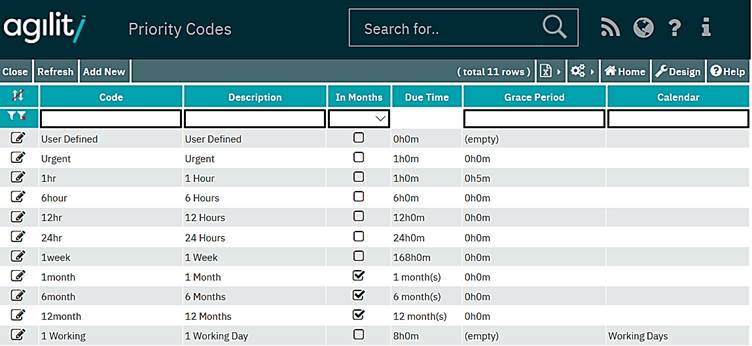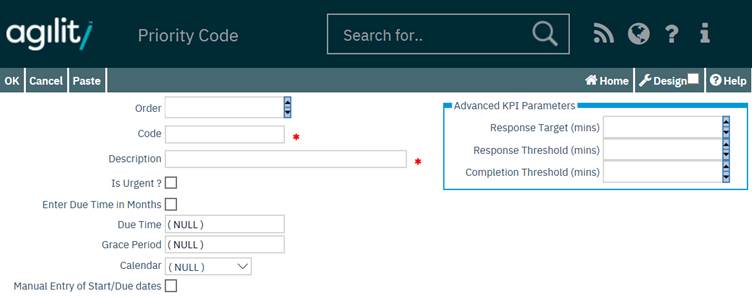Priority Codes
Accessed from >> Standing Data >> Work Orders >> Priority Codes
This Standing Data file is used for defining the priorities which will be allocated to a Work Order. The details of the Priority are the used by the system when calculating the Due Dates of Work Orders, as well as facilitating ‘grace’ time.

Creating a new priority code

Code
This is a unique code to identify this Priority Code. The field is free text.
Description
This is a free text field to describe the priority.
Due Time
The Due Time will be used in calculating the Due Date and Time on the Work Order. The due date and time is calculated by adding the specified time onto the start date and time specified on the Work Order.
The Due Time is specified hours and minutes.
It is also possible to enter the due time in months by checking the ‘Enter Due Time in months’ box.


Grace Period
The Grace Period is used when reporting on overdue Work Orders. The Grace Period, if specified, does not affect the due date of a Work Order.
An example of grace period usage:
A Work Order is raised on January 10th with a priority of 1 Month. This would give a calculated due date of February 10th. The Priority of 1 Month has a Grace Period of 2 days. If the Work Order remained “uncompleted” it would not be classed as Overdue until February 13th.
By default, the Grace Period can be added in hours and minutes.
Calendar
Calculation of the job due date can be done on the basis of a 24/7 working week or based on a specific calendar. When the calendar is filled in on the priority record, this will be used in the due date calculation, which will take into account calendar working hours for each day of the week (see Calendars for details) and calendar exceptions, which can include company-specific holidays.
An example of Calendar usage could be:
A Priority code has a due time of 6 hours and uses a Calendar that indicates working hours are 09.00 to 17.00, 5 days a week (Mon – Fri).
If a Work Order is raised at 14:00 on Monday with the 6-hour priority code, it would be unacceptable to calculate the Due Date & Time as 20:00 on the same day as the maintenance operation stops at 17:00.
By using the Calendar function, the due date on the Work Order would actually be calculated as 12:00 on Tuesday (i.e. 3 hours from 14:00 on Monday & 3 hours from 09:00 on Tuesday).
Manual Entry of Start/Due dates
If this option is checked the start date and due date can be manually overridden on the Work Order by the user.
Advanced KPI Parameters
The KPI parameters are used to enable the monitoring of response times using Work Order scan forms of defined KPI charts.

The parameters allow a threshold time in minutes to be specified which can be used to make the system display a warning, on a scan form or chart; for example, the deadline due date and time is approaching. The system Work Order scans “Completion Target RAG Scan” and “Response Target RAG scan” show this. The column sort on these grids also allows the grid to be ordered so that all tasks showing concern appear at the top.
Three thresholds can be specified:

Response Target
This is the number of minutes within which the Work Order has to be responded to. This figure is used to calculate the ‘Response Target Date’ on a Work Order based upon the following calculation.
Work Order Start Date Time + Response Target
Response Threshold
This is a number of minutes prior to the where you would want to be warned that the target is approaching. This figure is used to calculate the ‘Response Warning Date’ on a Work Order based upon the following calculation.
(Work Order Start Date Time + Response Target) – Response Threshold
Completion Threshold
This is a number of time in minutes prior to the Work Order due date/time when you would want to be warned that the Work Order is approaching the due date/time. This figure is used to calculate the ‘Completion Warning Date’ on a Work Order based upon the following calculation.
Work Order Due Date Time – Completion Threshold